One
CAVALRY SENT WEST
The photographs in this section depict the early period of California history. It was a period of power struggles between the Californio rancheros, indigenous nations, and Mexico. In 1846, Pres. James K. Polk and Secretary of War William Marcy ordered Col. Stephen W. Kearney, commander of the 1st Dragoons, the early 1st Cavalry, to march into California and seize Monterey and San Francisco. Polk and his administration wanted to ensure that, if peace agreements were made with Mexico, the United States would achieve military control of California.
Cavalry regiments sent into the Western United States were tasked with forcibly acquiring real estate, maintaining a power position through either violent means or forced treaties, and controlling newly acquired land. This included processes of attempted extermination and relocation of Native Americans, the owners of the real estate. It also included establishing military posts, towns, and rail lines to claim the land and protect the new white westward immigration across the continent, and it included the planned systematic extermination of the Plains Indians’ main resource, the buffalo.
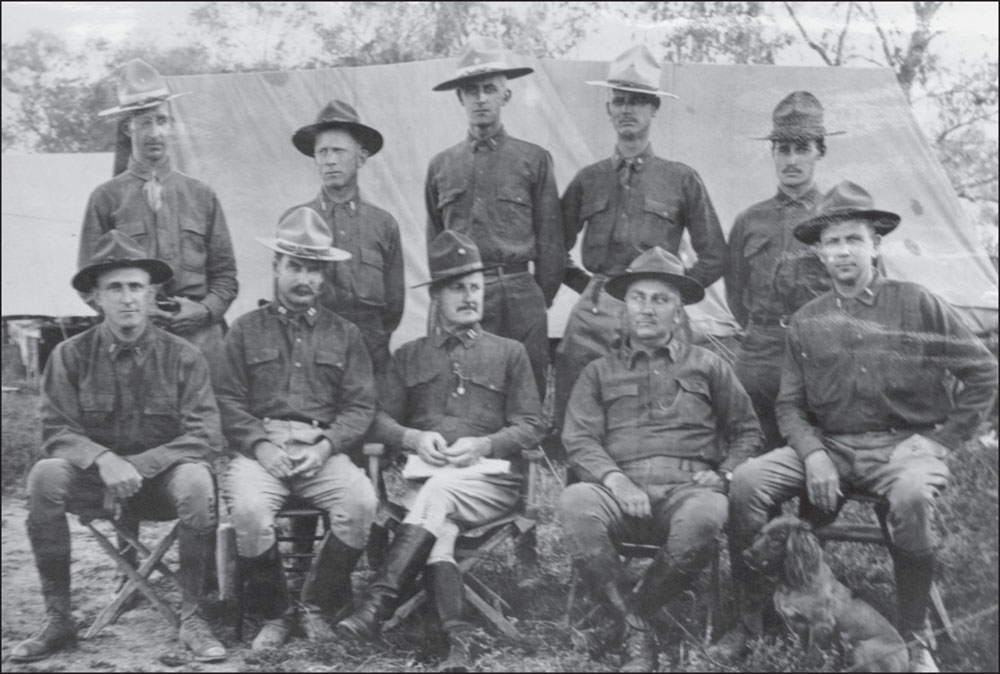
Pictured are the officers of Troops D and L of the 1st Cavalry, also known as the Machine Gun Platoon and Field Artillery Battery. From left to right are (sitting) Lieutenant Haiz; Captain Poillon, 1st Cavalry, Troop D, commander; Captain Harbord, 1st Cavalry, Troop L; Captain Hilton; and Lieutenant Van Kirk, MD; (standing) Lieutenant Kabbi, 1st Cavalry, Troop L; Lieutenant Bell, 1st Cavalry, M.C. Platoon; Lieutenant Brown, 1st Cavalry, Troop D; Lieutenant Wainwright, 1st Cavalry, Troop L; and Lieutenant Spencer, 1st Cavalry, Troop D. Hilton’s dog, Tony, is also pictured. (NARA 106817.)
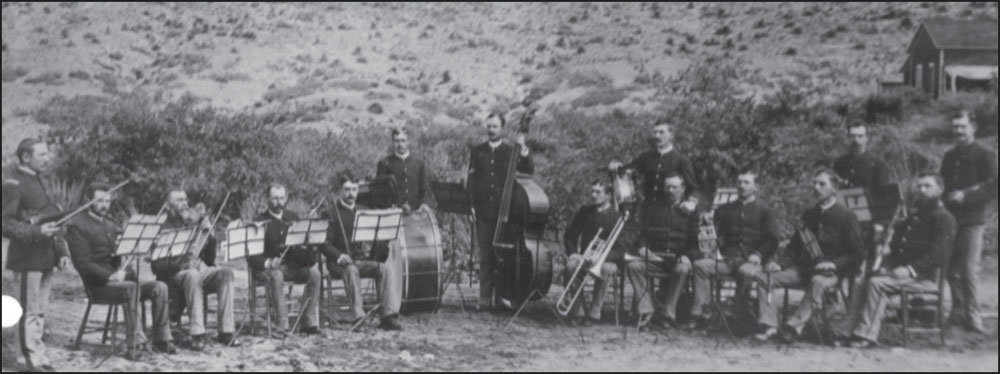
The 4th Cavalry Orchestra is pictured at Fort Bowie after Geronimo’s surrender in 1886. Geronimo (Mescalero Chiricahua) Goyathlay was a leader of the Bedonkohe Apache Nation. In 1858, Mexican soldiers attacked and killed his mother, wife, and three children, after which he pursued and fought Mexico and the United States for several decades. Some of the people identified in the photograph are William A. Raymond, Charles Kimball, Peter Siteloronor, Thomas O’Brien, and John J. Kelley. (NARA 87373.)
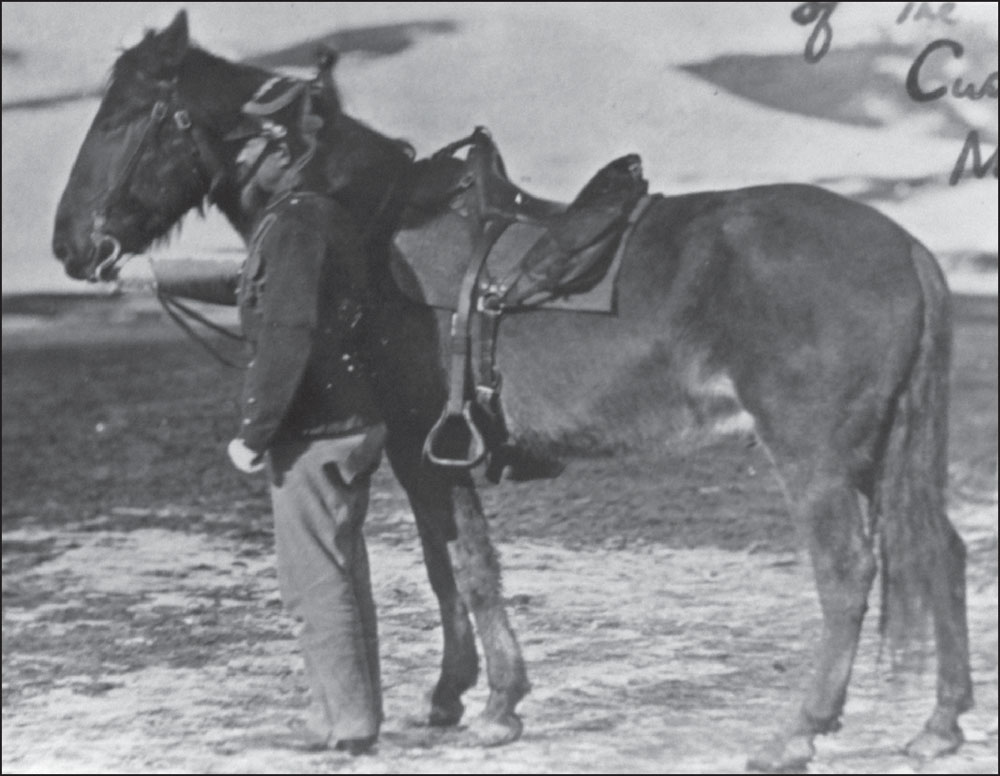
Captain Keogh’s horse Comanche was the sole survivor of the Custer massacre. Comanche was captured somewhere on the southern plains and brought to a remount station in St. Louis, Missouri, in 1868. There, he was broken in and then shipped to Fort Leavenworth. At the fort, he was selected to be loaded on a train bound for Ellis Station, where the 7th Cavalry was encamped. He arrived at the encampment on May 19, 1868, and caught the eye of Captain Keogh, and they were inseparable until the Battle of Little Bighorn in June 1876. (NARA 111-SC-83342.)
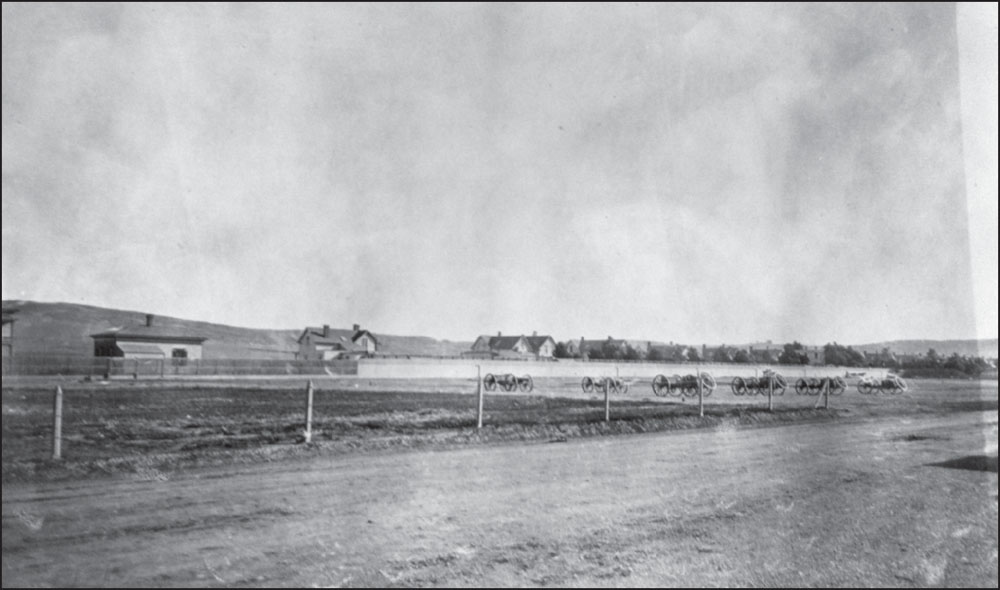
Originally ruled by Mexico, the Presidio in San Francisco came under the control of the United States in 1846. With the discovery of gold in California in 1849, the US government established the Presidio as a permanent military post. During the 1870s through the 1880s, the Presidio was camp to many cavalry regiments ordered to fight the Modoc Nation in Northern California and the Apache Nation in the southwest plains. (NARA 87839.)
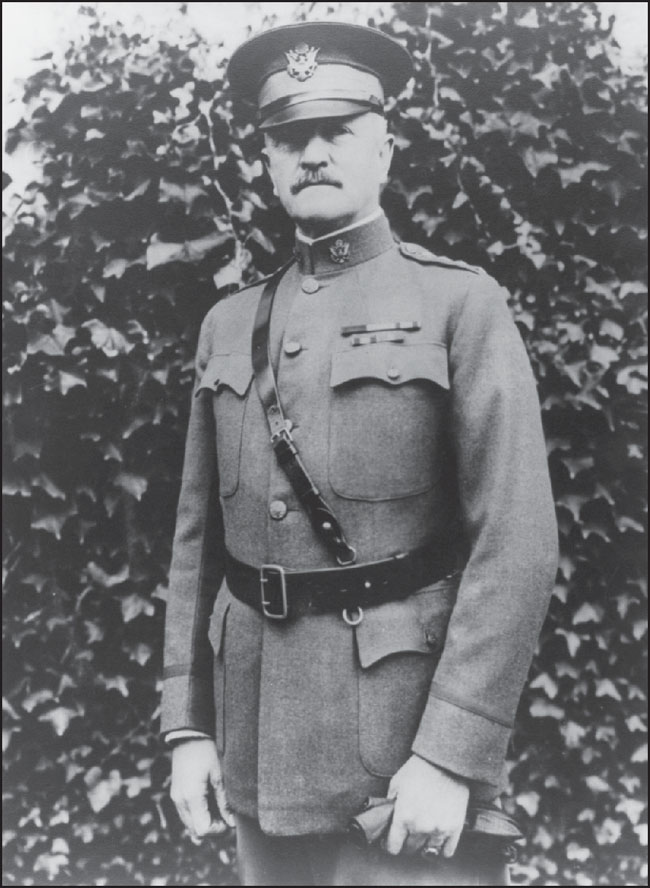
In 1914, Gen. John J. “Black Jack” Pershing commanded the 8th Cavalry, dispatched from the Presidio to pursue Mexican revolutionary Francisco “Pancho” Villa. While Pershing was on the expedition, his wife, Frances, and their three daughters perished in a fire; only their five-year-old son, Warren, survived. (NARA 87841.)
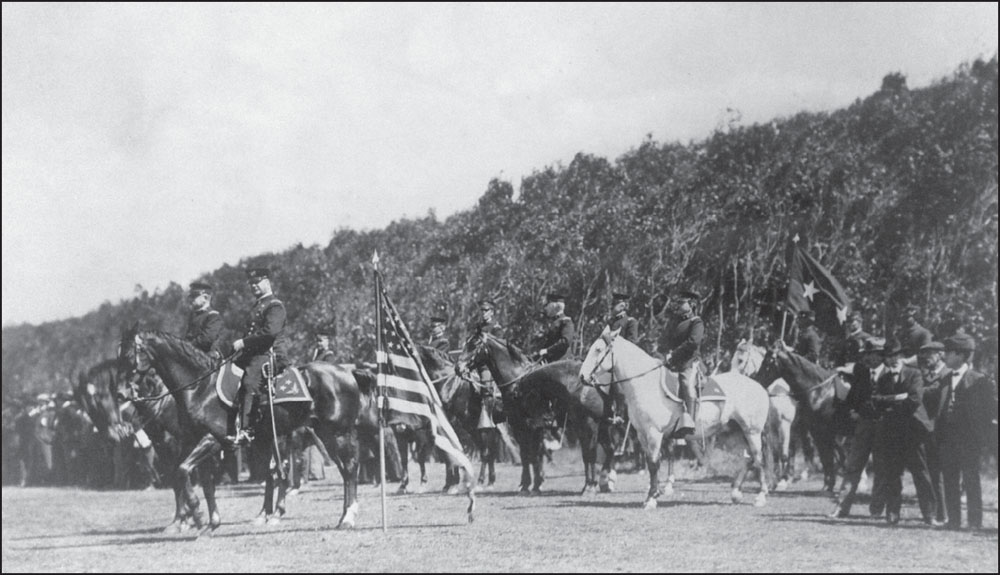
Maj. Gen. Arthur McArthur, who changed his name to “MacArthur” after the Civil War, was commissioned a brigadier general in 1896. He fought in the Spanish-American War and was appointed military governor of the Philippines from 1900 to 1901 during the American occupation. He died of a massive heart attack on September 5, 1912, while addressing a reunion of veterans from the 24th Wisconsin Infantry. Here, he is seen commanding a review of troops at the Presidio of San Francisco in 1904. (NARA 83641.)
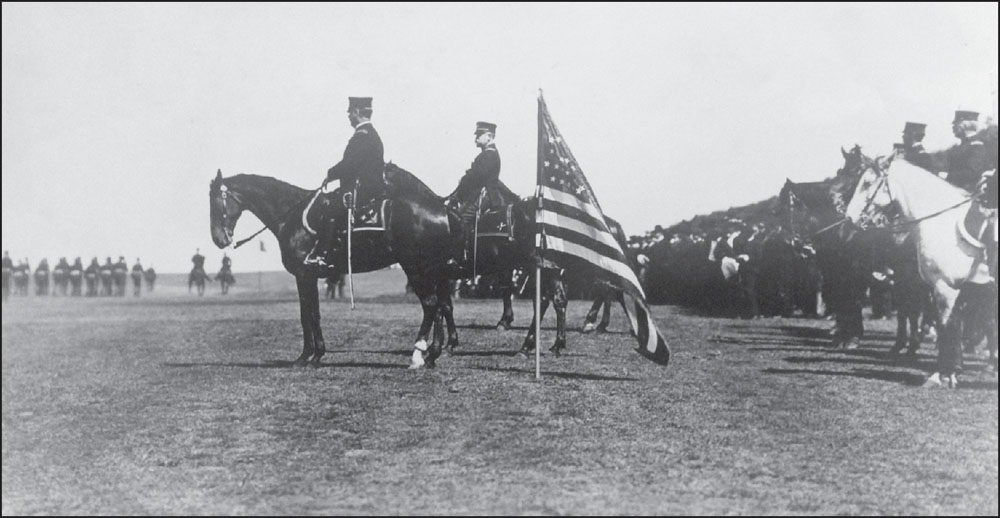
Maj. Gen. Arthur McArthur was father to Douglas MacArthur, the first father and son to both be awarded the Medal of Honor. Here, Maj. Gen. Arthur McArthur is seen commanding a review of troops at the Presidio in 1904. (NARA 83640.)
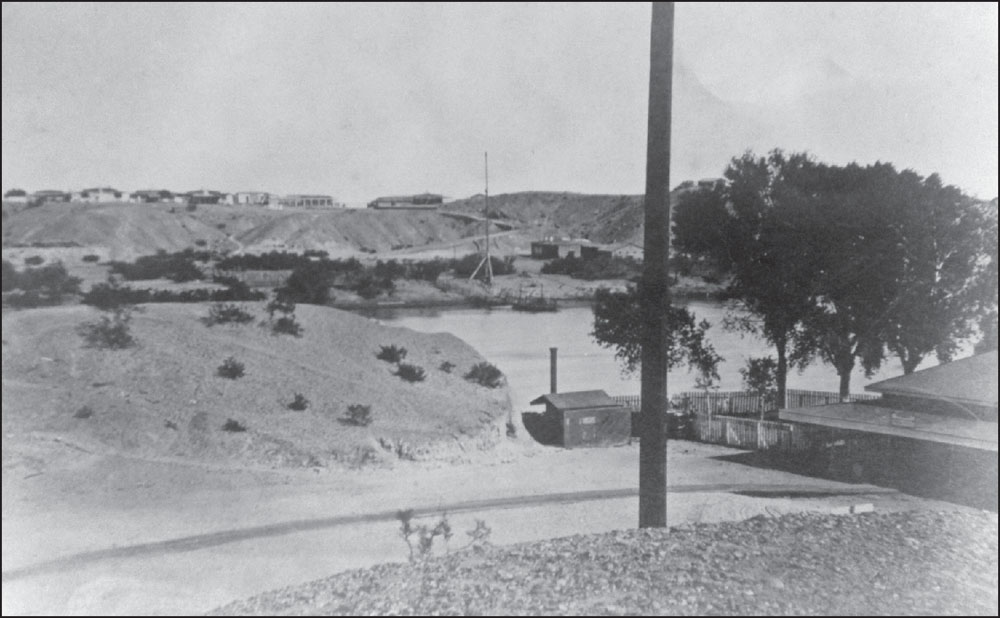
Pictured here is Fort Yuma, known for its relentless heat. Gen. George C. Thomas, commander from 1851 to 1855, recollected: “One of the most disagreeable posts garrisoned by the Army ... 116 degrees in the shade. Sleep before midnight was impossible and then only on the rooftops.” (NARA 87799.)
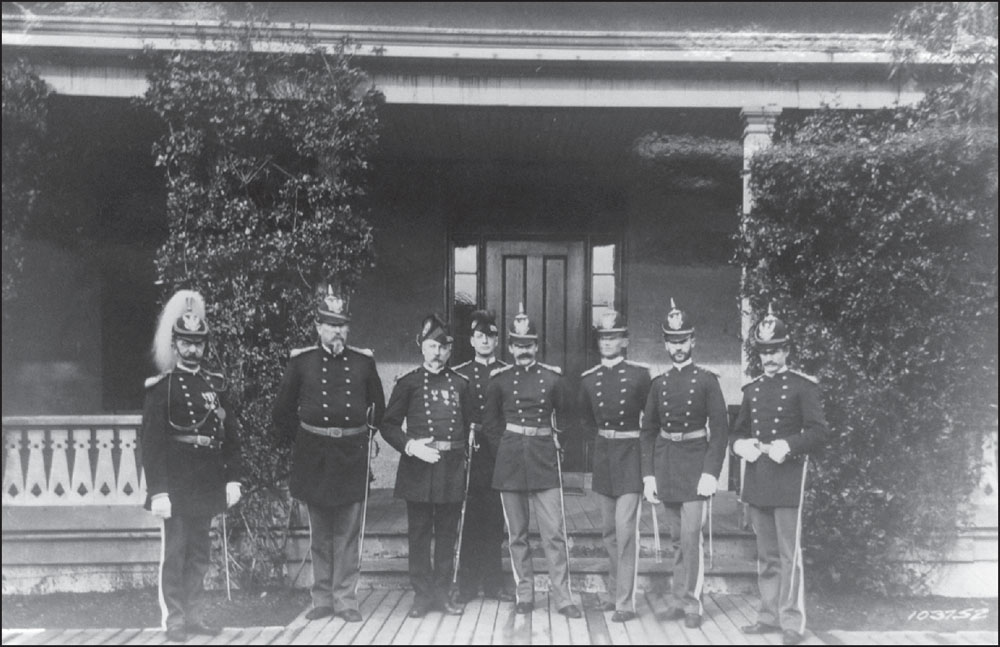
Officers stationed at Benicia Barracks, California, in January 1896, pose for a photograph. Many of these men were later to be stationed in Yosemite National Park. Third from right appears to be Merritte Weber Ireland, who became the US surgeon general from October 4, 1918, to May 31, 1931. (NARA 103752.)

Camp Merritt in San Francisco is pictured in 1898. The camp was also known as the “Concourse,” a trotting racetrack south of the Presidio and north of Golden Gate Park. It became Camp Merritt on May 29, 1898, and operated only long enough for a fleet to be assembled for the 18,000 troops disembarking for the Philippines. (NARA 82962.)
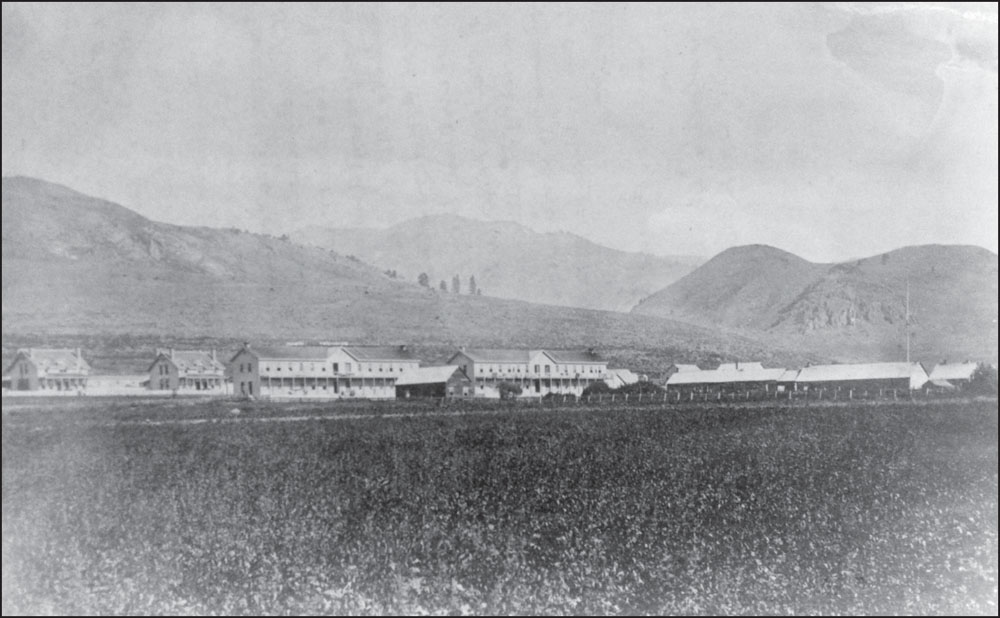
When Fort Bidwell was established in 1865, the cavalry was tasked with protecting white immigrant settlers from the Modoc Nation. The Fort Bidwell general store, built in 1874, remains one of the longest continuously operating stores in the state of California. In 1893, Fort Bidwell was converted into a government boarding school for Native American children, who were captured and forced to assimilate to Western culture. (NARA 83466.)

Pres. Millard Fillmore declared Alcatraz in San Francisco a military reservation in 1850, and by 1859, troops were permanently garrisoned at the post. About 40 years later, members of the Hopi Nation were imprisoned on Alcatraz for resisting the policy of forced education and assimilation of their children. By 1907, Alcatraz was designated a US military prison. Officers at Alcatraz are seen here in 1905. In 1969, the American Indian Movement occupied Alcatraz, marking the beginning of modern-day Native American political activism. (NARA 103753.)
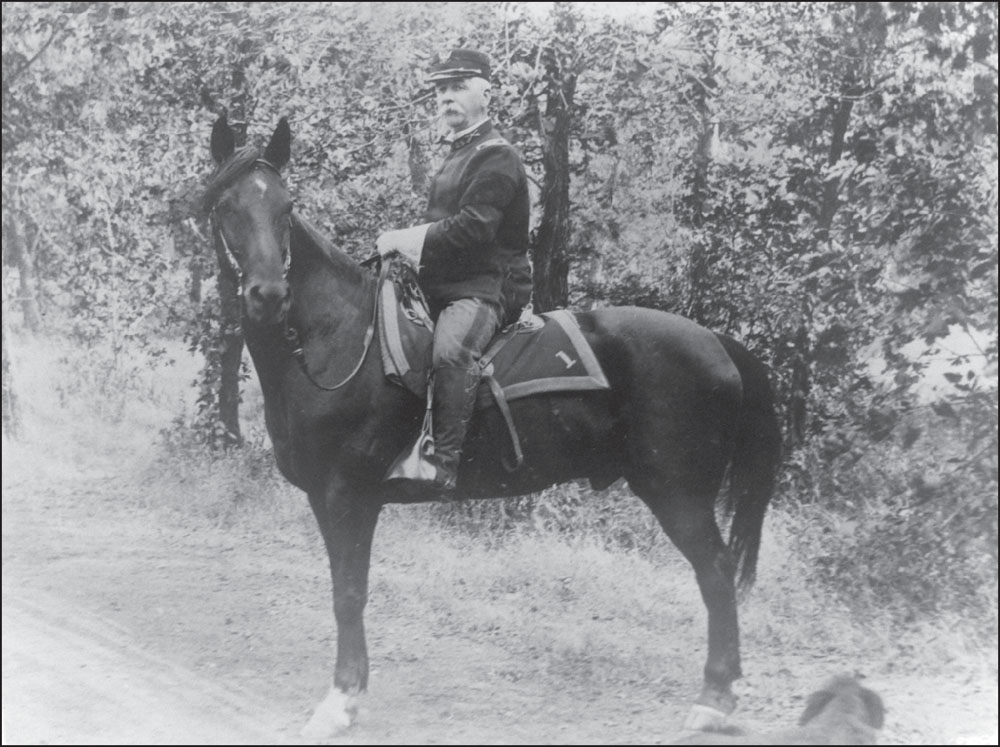
Col. Abraham Kerns Arnold (pictured) was part of the 1st Cavalry Regiment, formed in June 1832 as a battalion of mounted rangers, to fight the Black Hawk War. It was officially recognized by Congress as the US Regiment of Dragoons on March 2, 1833. It held its last mounted review as a regiment of a horse cavalry on December 14, 1932. On January 16, 1933, the 1st Cavalry became the first mechanized unit in the US Army. (NARA 107680.)
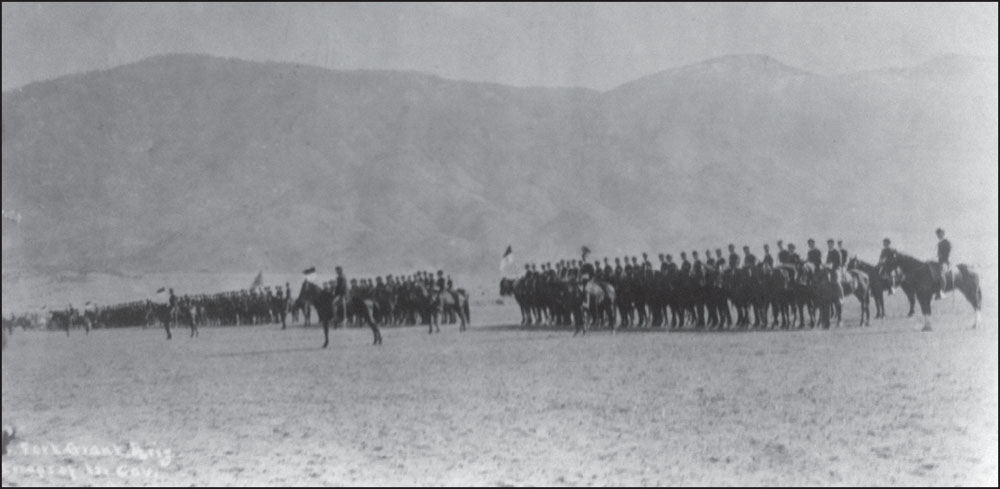
Pictured are troops of the 1st Cavalry standing at inspection at Fort Grant, Arizona, in 1893. The 1st Cavalry Regiment received five battle honors during the war with Mexico. The unit took part in the Battle of Santa Cruz de Rosales in Mexico after having marched 210 miles in four days and nights to reach it. (NARA 83491.)
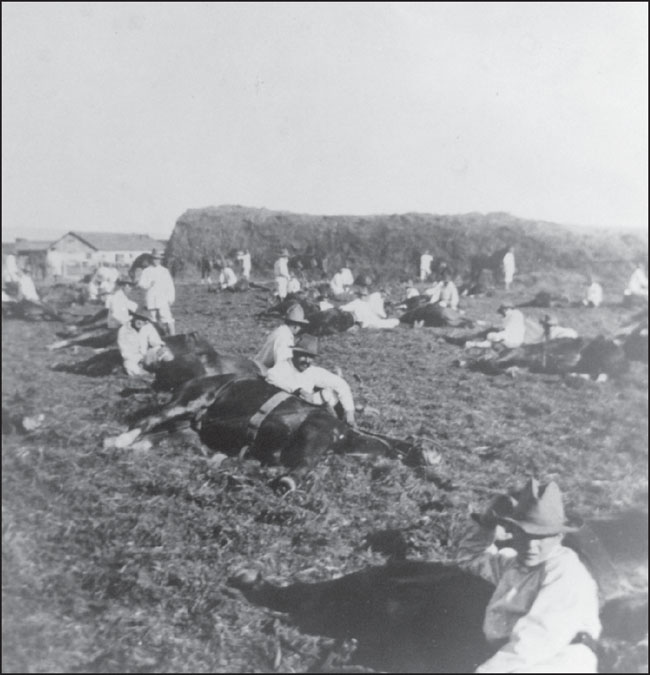
At Fort Washakie, Wyoming, in 1899, Troop E of the 1st Cavalry is seen training the cavalry horses to lie down. Shooting from behind the horse was rarely used in battle since it was dangerous to the rider. It is possible that scouts used this technique in order to hide their horses during reconnaissance. During the Battle of Little Bighorn, Captain Keogh’s troops shot their horses in desperation to use them for cover. (NARA 83506.)
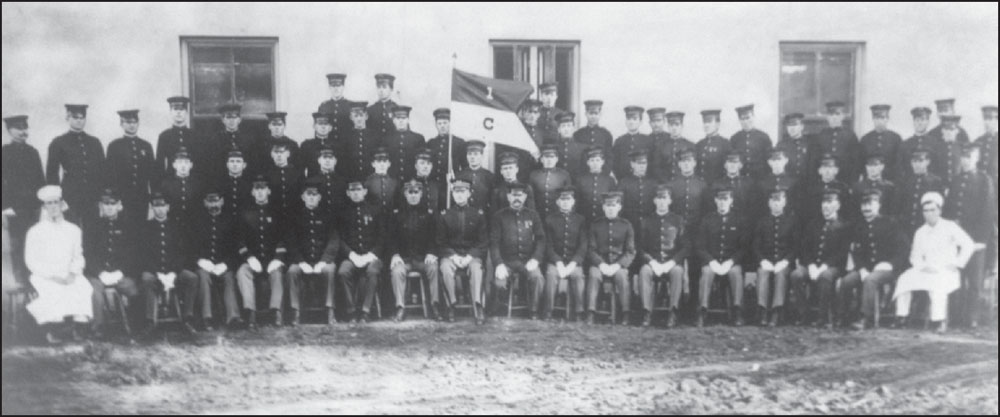
Pictured is Troop C, 1st Cavalry, at the Presidio in San Francisco on December 25, 1912. This photograph was used as the menu card for the Christmas dinner. Just a few years later, these troops were dispatched to pursue Pancho Villa in Mexico under the command of Gen. John Pershing. (NARA 106818.)
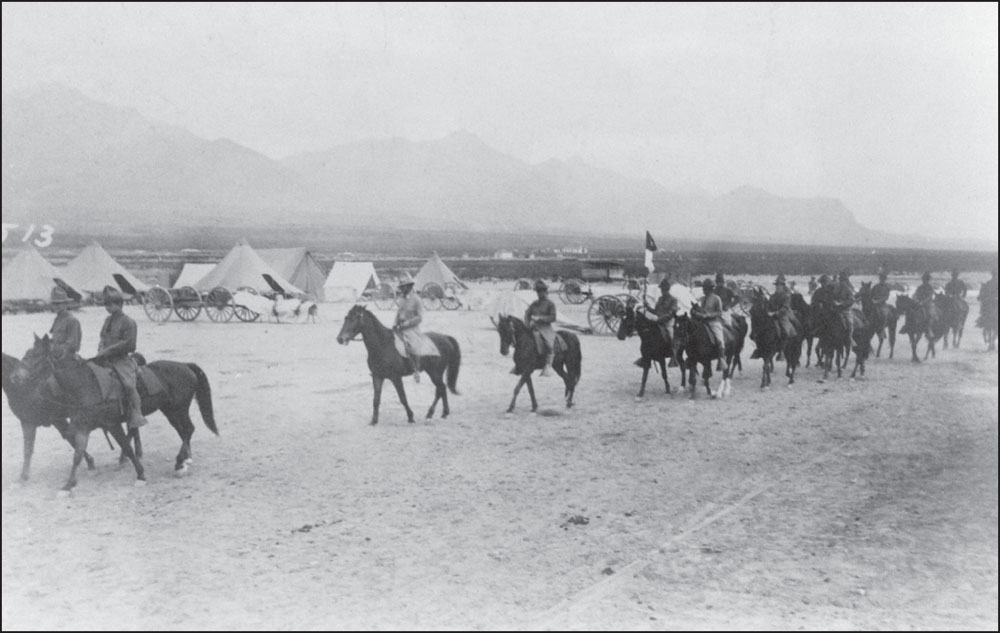
Here, Troop I of the 2nd Cavalry is returning from drill at Fort Bliss, Texas, in 1912. At this time, skirmishes on the Mexican border were constant. The 2nd Cavalry, which was eventually sent to camp southeast to protect another area, was often attacked by Villa’s soldiers. (NARA 108543.)
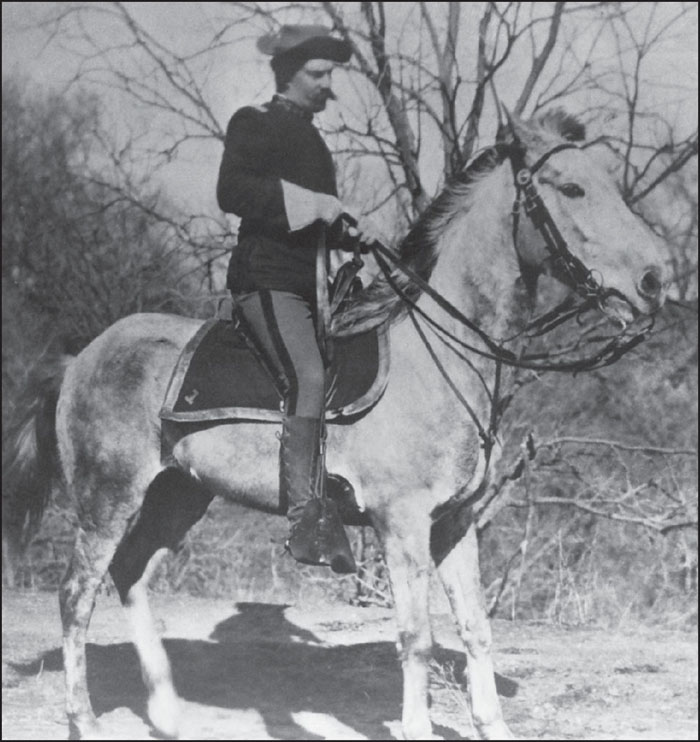
1st Lt. George W. Goode commanded Troop H of the 1st Cavalry, was the commanding officer of Fort Yellowstone, and was designated the acting superintendent of the park, reporting to both the Army and the Department of the Interior. (NARA 105635.)
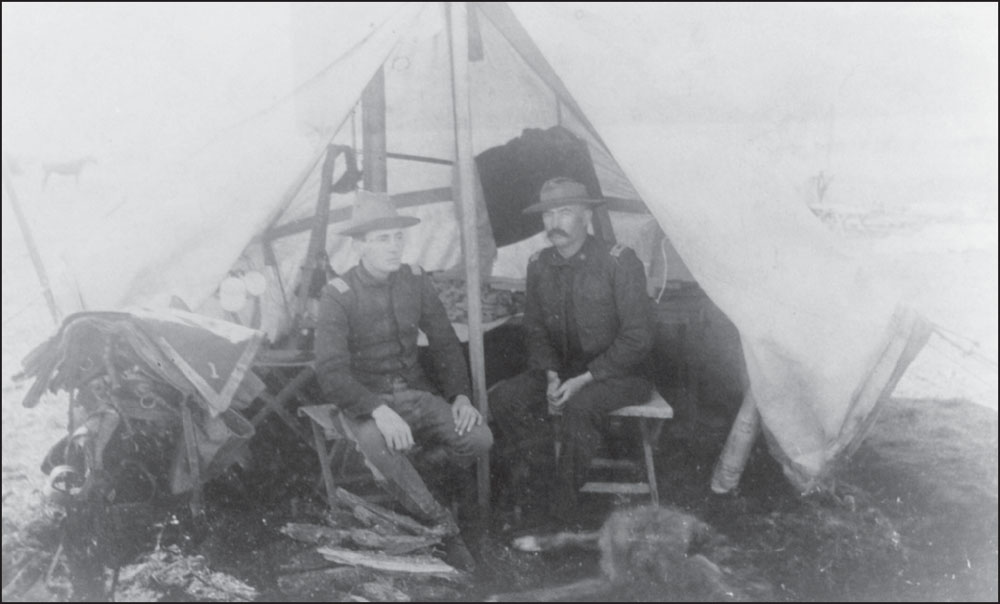
Lt. J.S. Herron of the 1st Cavalry is pictured on the left. He commanded Troop H in the field on maneuvers with the 10th Infantry, located 100 miles north of Fort Sill, Oklahoma. On his right is Capt. J.D. Glennan of the Medical Corps, who was on duty with troops as medical officer. The troops were ordered from Fort Sill to Fort Reno due to increased pressure from Indian groups. 1896 (NARA 104499.)
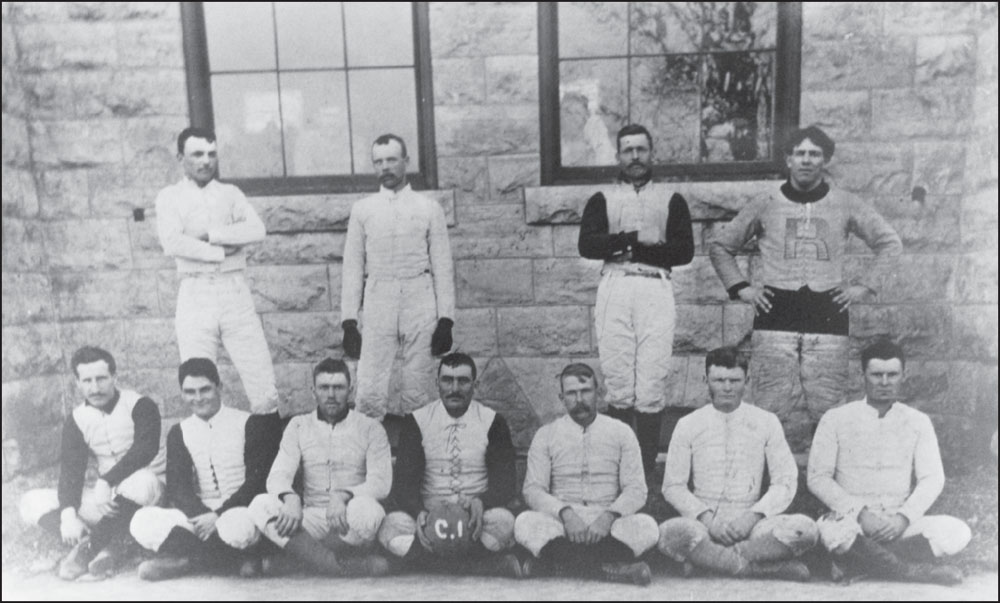
This is the football team of Troop C of the 1st Cavalry at Fort Riley, Kansas, in 1895. After the Pershing expedition in Mexico, Fort Riley began its Mounted Service School, which became highly regarded. Fort Riley was established originally to protect people traveling to Oregon, Colorado, Utah, New Mexico, Arizona, and California from any indigenous nations who resisted new immigrants on their land. (NARA 107687.)
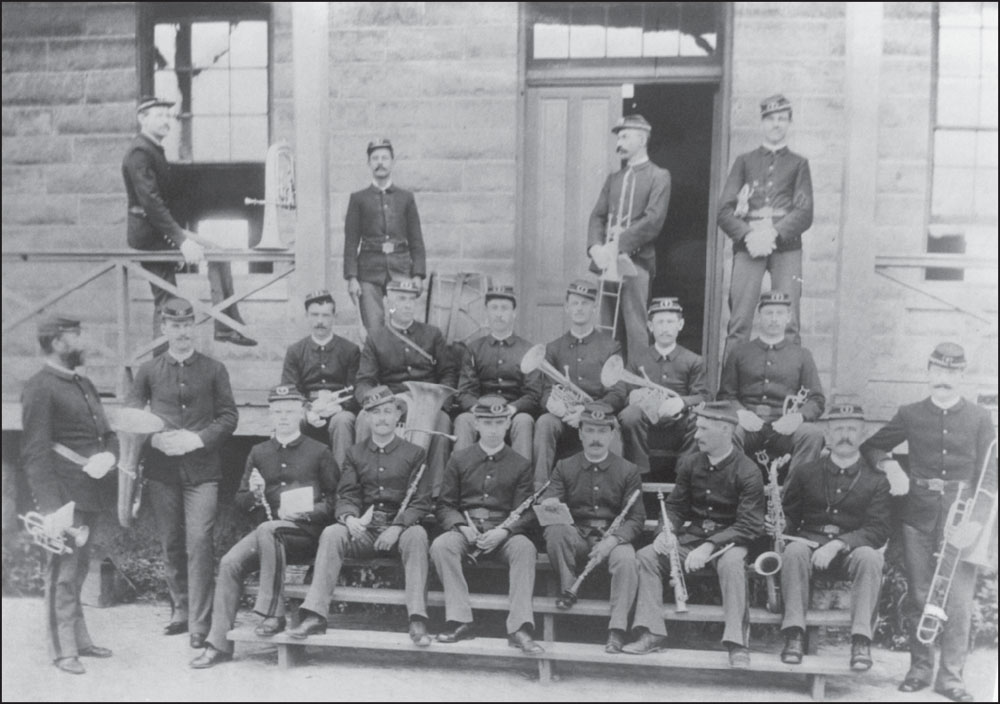
Bugles and drums were used to send information quickly through the camps. A bugle call was used to assemble buglers, while reveille meant that soldiers should exit their tents and stand in formation. The stable call was meant for men to clean and feed their horses. There was a breakfast call and a boots and saddles tune, calling troops to saddle up. There were also tunes to go to bed, to go into fight, to trot one’s horse, to move left or move right, to charge, or disperse. (NARA 107681.)
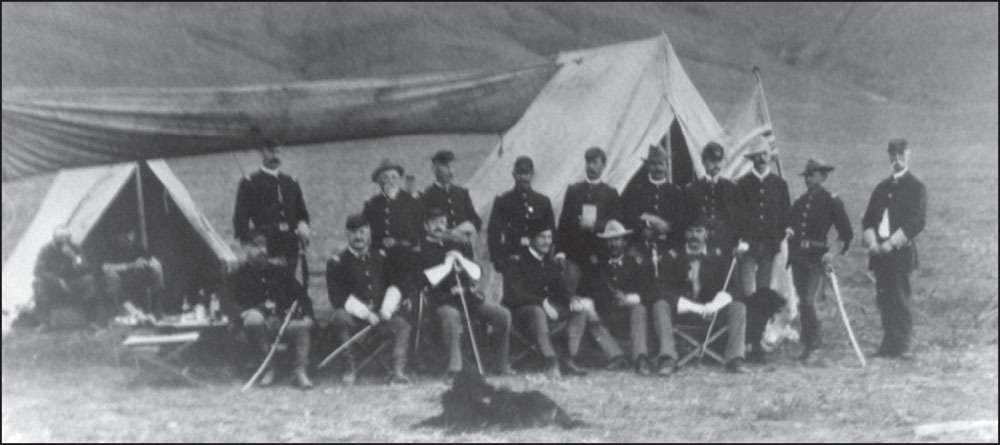
The 1st Cavalry camped at Helena, Montana, in the summer of 1884. From left to right are (first row) Capt. Henry Wagner, Capt. Camillo C.C. Carr, Maj. George B. Sanford, 1st Lt. Frank A. Edwards, 1st Lt. John Pitcher, and 2nd Lt. Daniel L Tate; (second row) 1st Lt. Otto L. Hein, Capt. James Jackson, Capt. Moses Harris, Capt. Albert G. Forse, 2nd Lt. James B. Aleshire, 2nd Lt. Albert L. Mills, Dr. Kneedler, 1st Lt. George B. Buackus, 2nd Lt. S. Foltz, and the contract surgeon. (NARA 104123.)
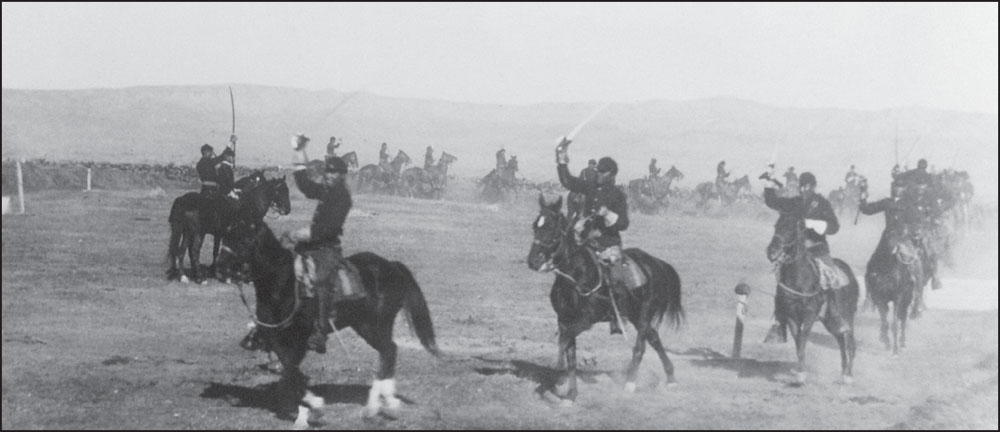
Here, Troop L of the 1st Cavalry in Fort Custer, Montana, is performing saber exercises in 1892. This troop was known as the Indian Troop. The 1st Cavalry was posted in the Western United States over a 60-year period and was tasked with annihilations and removal of people from their homes. The troop came in brutal contact with the Apache, Modoc, Nez Perce, Black Hawk, Comanche, Pawnee, Mojave, Crow, and the Sioux Nations during what is commonly referred to as the Indian Wars. (NARA 104128.)
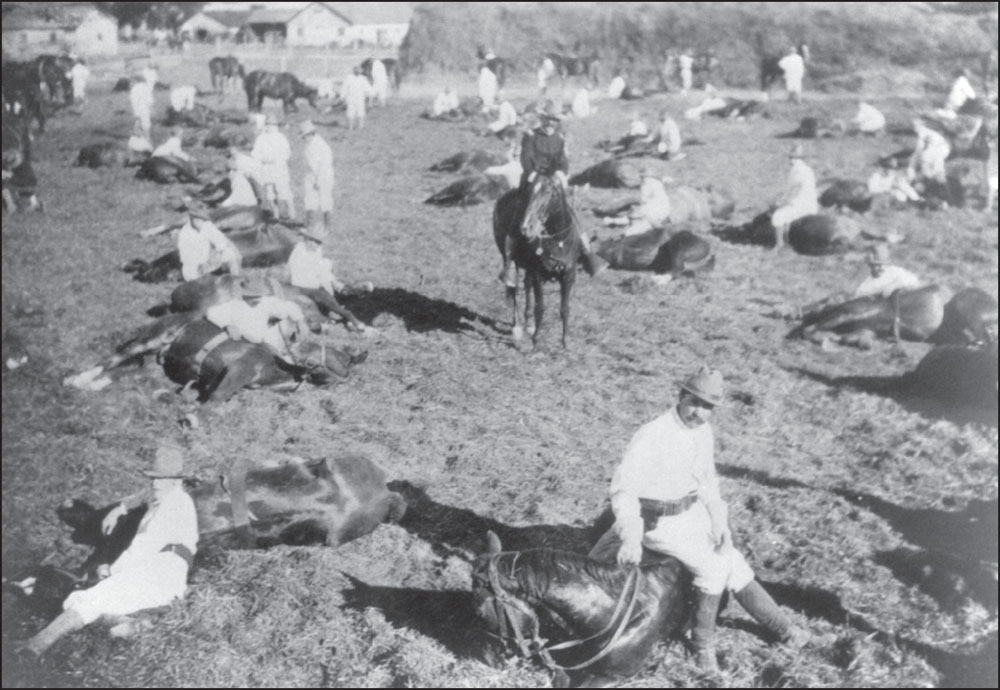
Troop E, 1st Cavalry, at Fort Washakie, Wyoming, is training horses in 1899. The art of maneuvering a horse is the combination of placement and tension of the reins and the placement and pressure of the trooper’s knees, upper legs, and lower legs. (NARA 83516.)
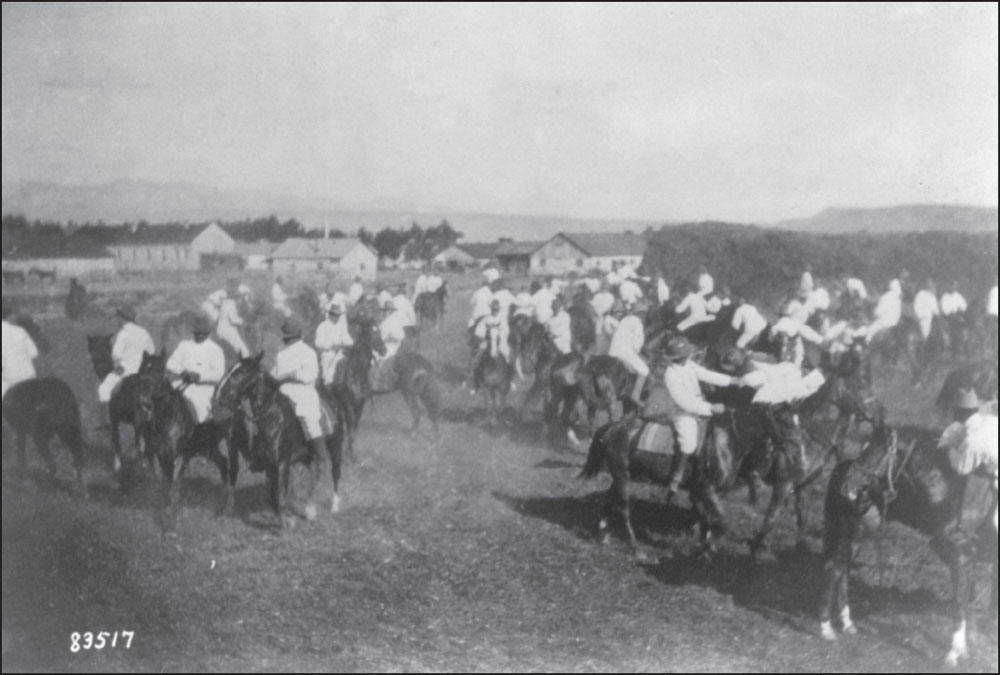
Troop E, 1st Cavalry, is seen here engaged in mounted wrestling drills at Fort Washakie, Wyoming, in 1899. It was extremely important to be practiced in hand-to-hand combat while working one’s horse. Often, troopers fought on the ground, but keeping one’s horse was preferable for safety and a competitive edge. (NARA 83517.)
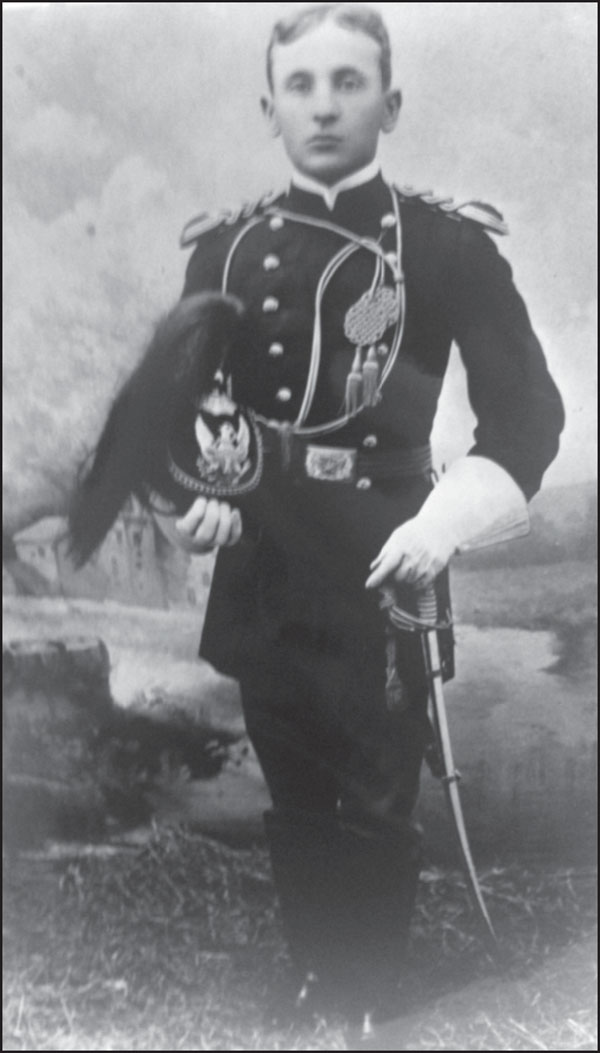
Seen here is 2nd Lt. Joseph F. Herron of Troop H, 1st Cavalry, in 1896. In 1899, he was detailed for duty with the Cook Inlet Exploring Expedition, commanded by Capt. Edwin F. Glenn; the expedition was directed to find a route from the Cook Inlet to the Yukon. (NARA 105616.)
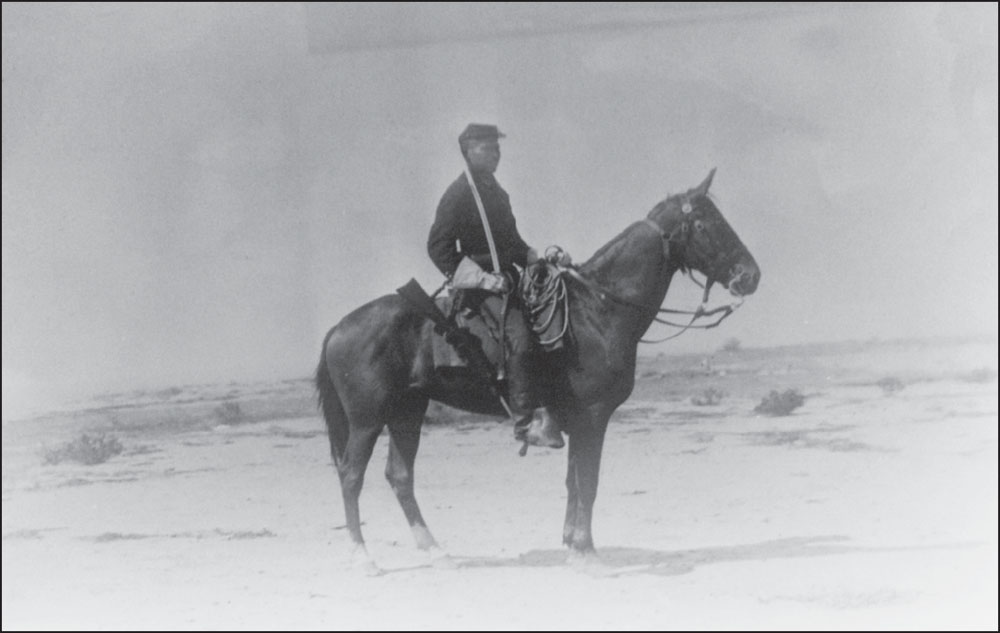
The Crow and Sahnish (also called Arikara), who were warring with the Lakota and Cheyenne, joined as troopers to assist in the extermination of their local enemy. Pictured here is a Crow trooper in Troop L of the 1st Cavalry, Fort Custer, Montana, in 1892. The 7th Cavalry was accompanied by a number of Crow, Sahnish, and Blackfoot scouts and interpreters. (NARA 104098.)
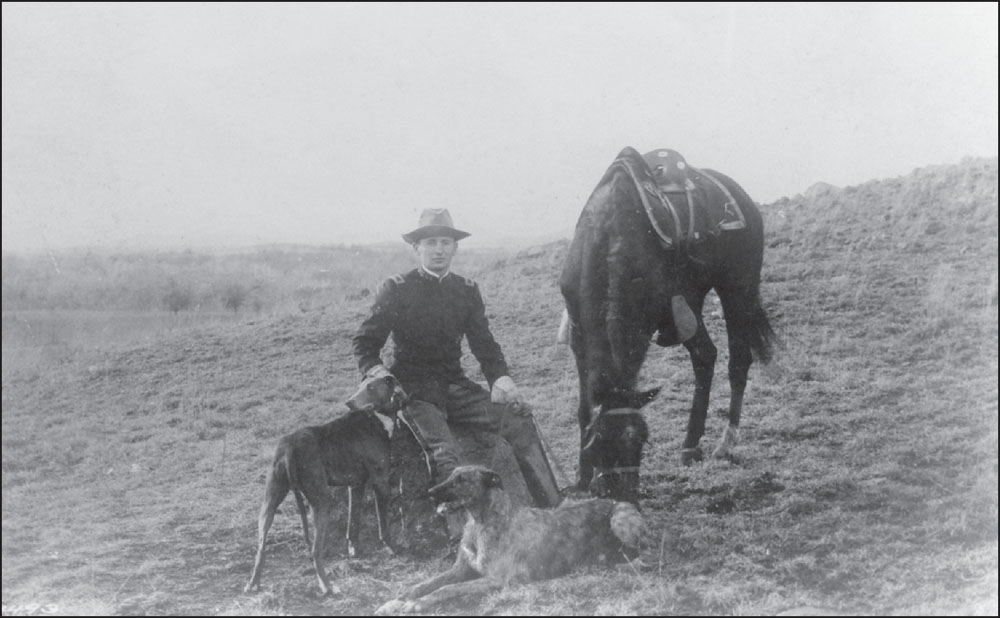
2nd Lt. Joseph F. Herron of the 1st Cavalry is pictured with his horse Kangaroo and hounds at Fort Sill, Oklahoma, in 1895. During World War I, Companies F, E, and C of the 1st Cavalry guarded the Mexican border, watching for Pancho Villa. (NARA 104493.)
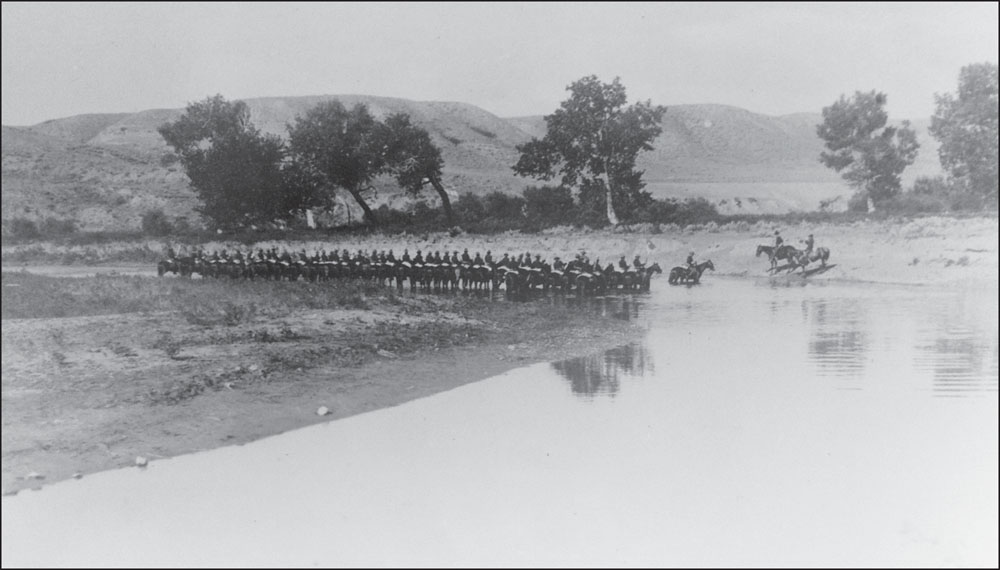
Here, Troop L of the 1st Cavalry waters their horses at the Little Bighorn River, near Fort Custer, Montana, in 1892. The area is where one of the largest battles in the systematic attempt to remove Native Americans took place, the Battle of the Little Bighorn, on June 25, 1876, between federal troops and two plains nations. Lt. Col. George A. Custer led the 7th Cavalry, and Crazy Horse led the Lakota and Sioux Nations. Fighting to stop the US government’s encroachment on their land and their way of life, Crazy Horse and his people won the Battle of Little Bighorn in June 1876. Custer and all his troops, scouts, and interpreters in Companies C, E, F, I, and L were slain. (NARA 104097.)
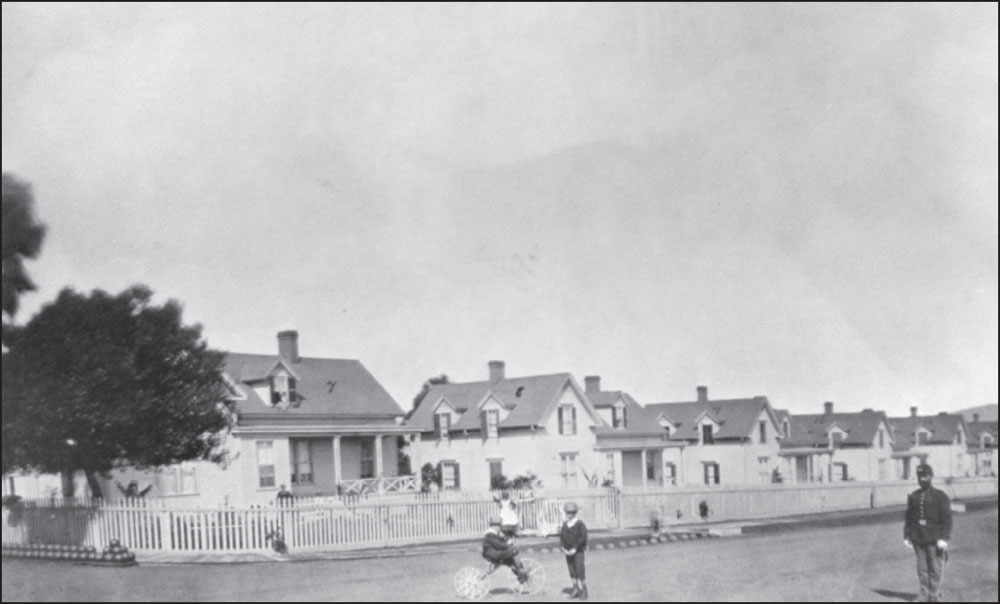
At the officers’ compound at the Presidio in San Francisco, the buildings are identified from left to right as belonging to the assistant adjunct general, chief paymaster, chief quartermaster, engineer officer, post surgeon, post commander, and captain of the light battery. (NARA 87846.)
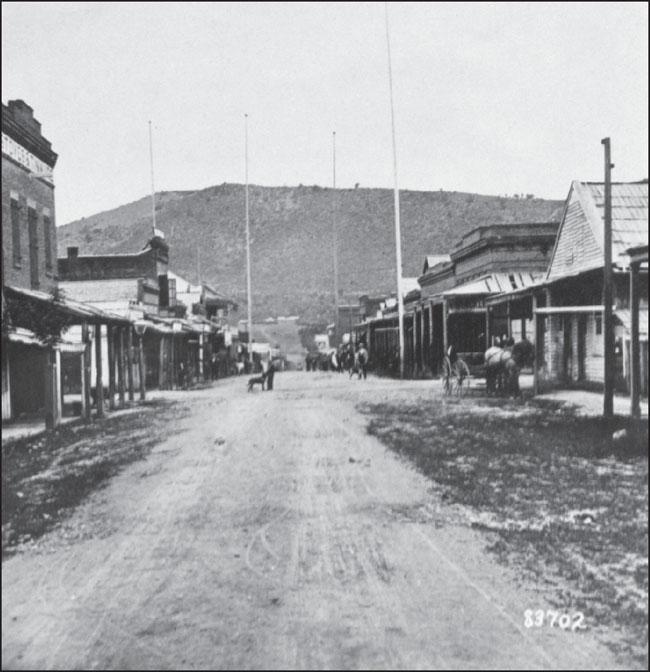
This streetscape is from Yreka, Siskiyou County, in Northern California on the border of Oregon, north of Mount Shasta. Gold miners created this town during the gold rush. Numerous tents, shacks, and a few cabins were erected quickly. The town had various names before Yreka. The 2nd Cavalry, Company M, were recruited volunteers from Siskiyou in 1861. They were first camped on the Overland Trail to assist new immigrants from attack by the area’s original owners. (NARA 83702.)
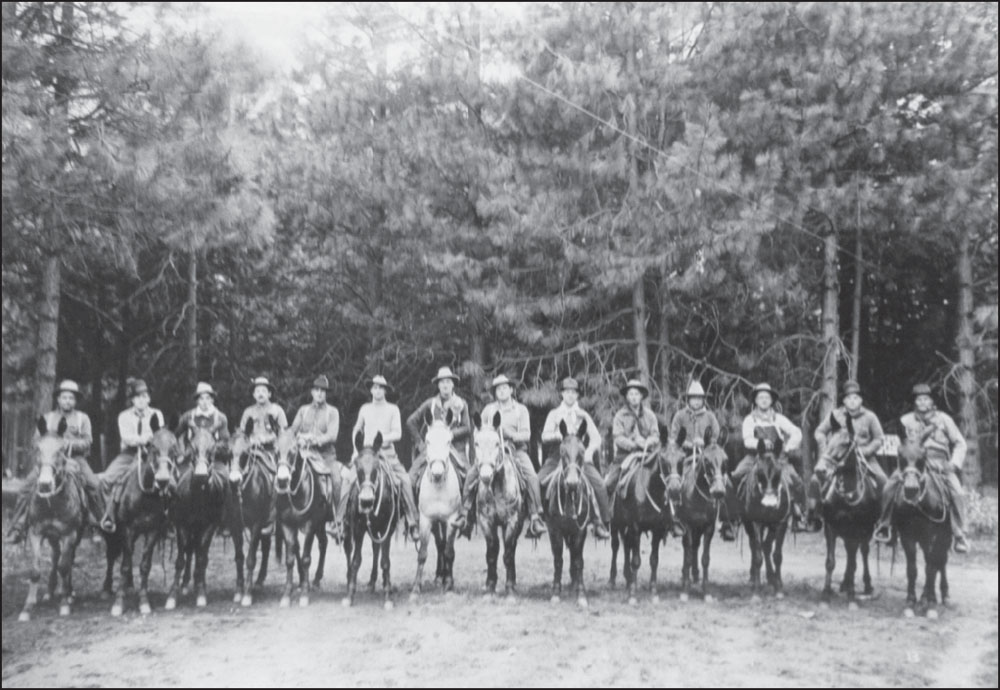
The personnel of pack train No. 5 pose in Yosemite, California. US Cavalry provided protection for Yosemite National Park between 1891 and 1913. The National Park Service today still emulates the operational structure and the attire of the cavalry. (NARA 87779.)
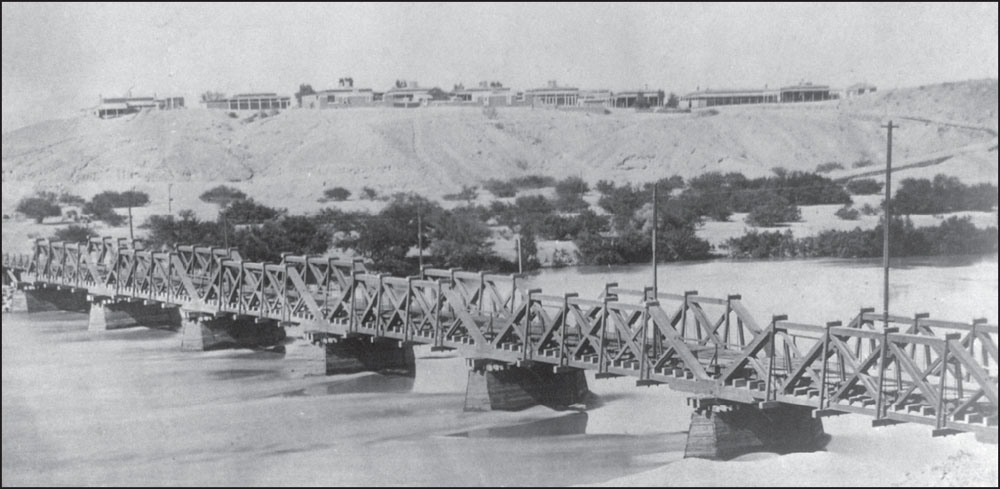
The Fort Yuma Bridge in California crossed the Colorado River, and this picture was taken from the Arizona side, in Yuma, in 1881. Fort Yuma was established to protect immigrants to California from Yuma Indians who lived in the surrounding area. Fort Yuma, California, was located on the Colorado River opposite the mouth of the Gila River until 1851, when the fort was moved to an elevated site opposite present-day Yuma, Arizona, and on the original location of the Mission Puerto de Purísima Concepción. (NARA 82433.)
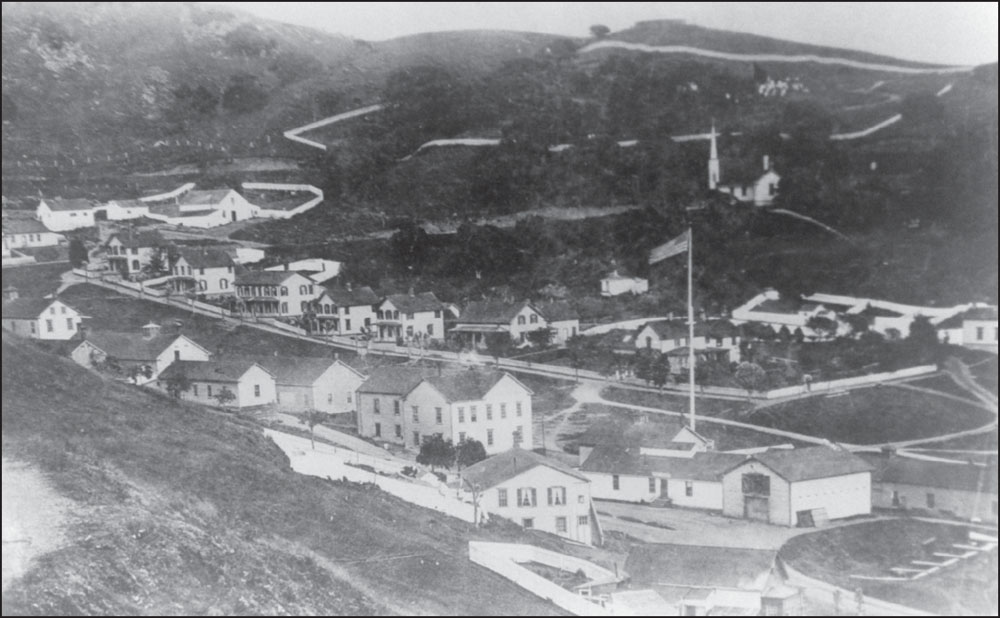
Seen here is Fort McDowell on Angel Island, San Francisco, in 1923. Fort McDowell, previously called Fort Reynolds, had been used as a recruit camp, an artillery post, and prison camp; by 1922, it had become an overseas discharge and replacement depot for processing personnel leaving and returning from overseas posts. Fort McDowell processed about 22,000 people each year between 1926 and 1938. (NARA 82440.)
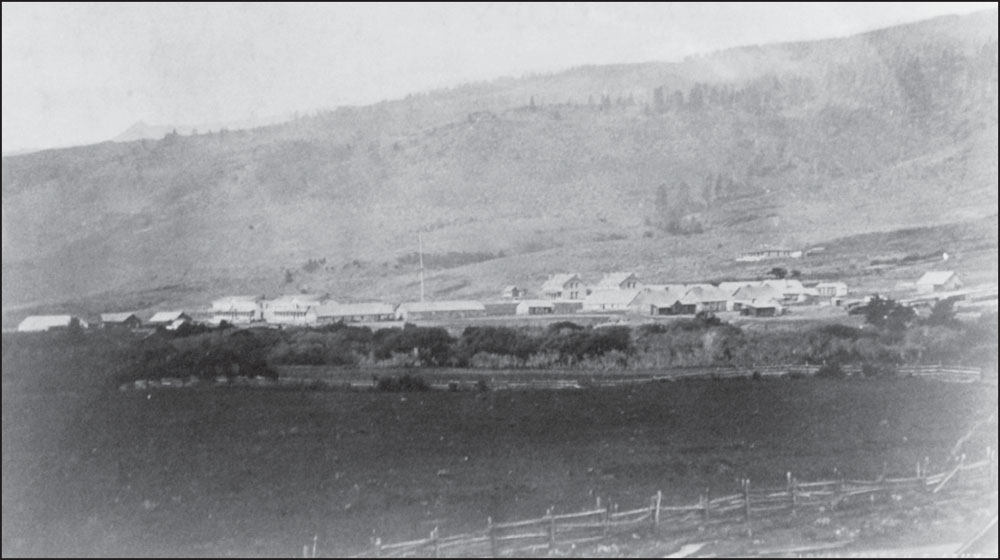
The parade grounds of Fort Bidwell, California, are seen here after new construction in 1875. Along the south side of the parade grounds were the kitchen and dining rooms and some of the older barracks, which were used for storage and offices. On the north side of the parade grounds were the officers’ quarters. On the west side were barracks, the commissary, a hospital, post office, and a saloon. On the east side of the parade grounds were the stables, not visible in this picture. (NARA 83391.)
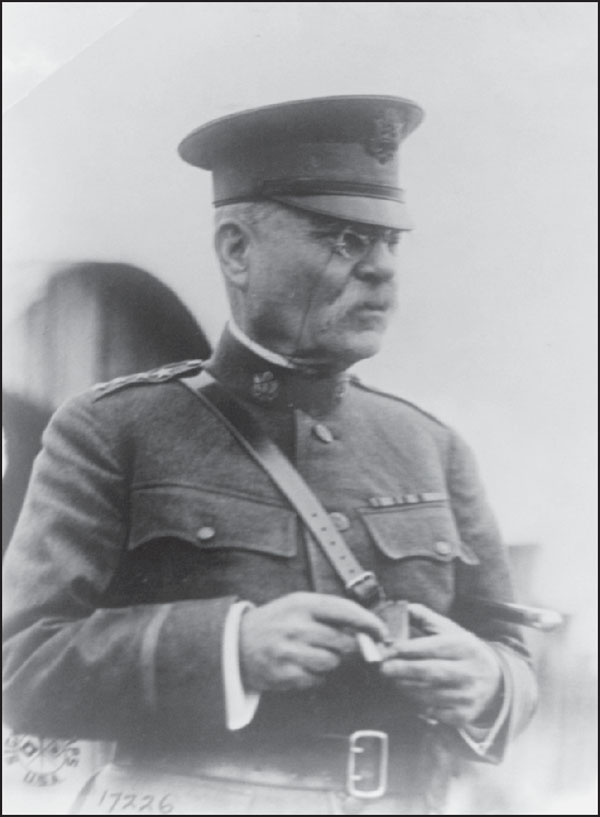
Gen. Tasker H. Bliss of the US Army Signal Corps is pictured here. Bliss was commissioned a second lieutenant in the 1st Artillery and had garrison duties in Georgia and New York. He served as an assistant professor of French at West Point from 1876 until 1882. In 1885, after duty in California and Virginia, he returned to academia as an instructor at the Naval War College. (NARA 17226.)
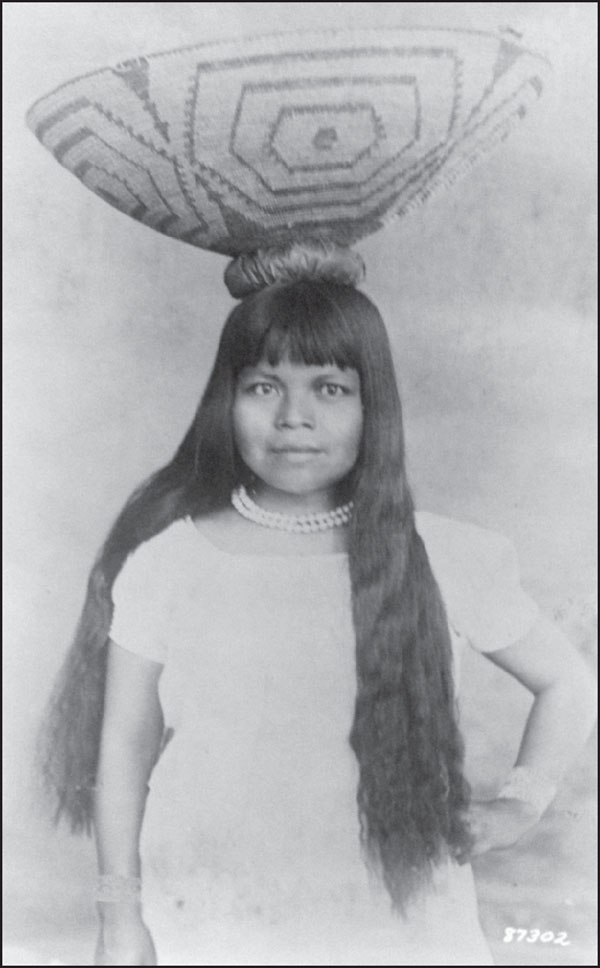
Pres. Andrew Jackson was the strongest proponent for the Indian Removal Act—also known as the Trail of Tears—and signed the act into law. Under Jackson, over 100 million acres of Indian land were reduced to less than 32 million acres. Extermination, through military attacks, and cultural assimilation, through forced boarding schools, were attempted during this period. In California, the native population prior to Spain’s invasion was nearly one million. By the end of the 19th century, it was less than 20,000. (NARA 83490.)
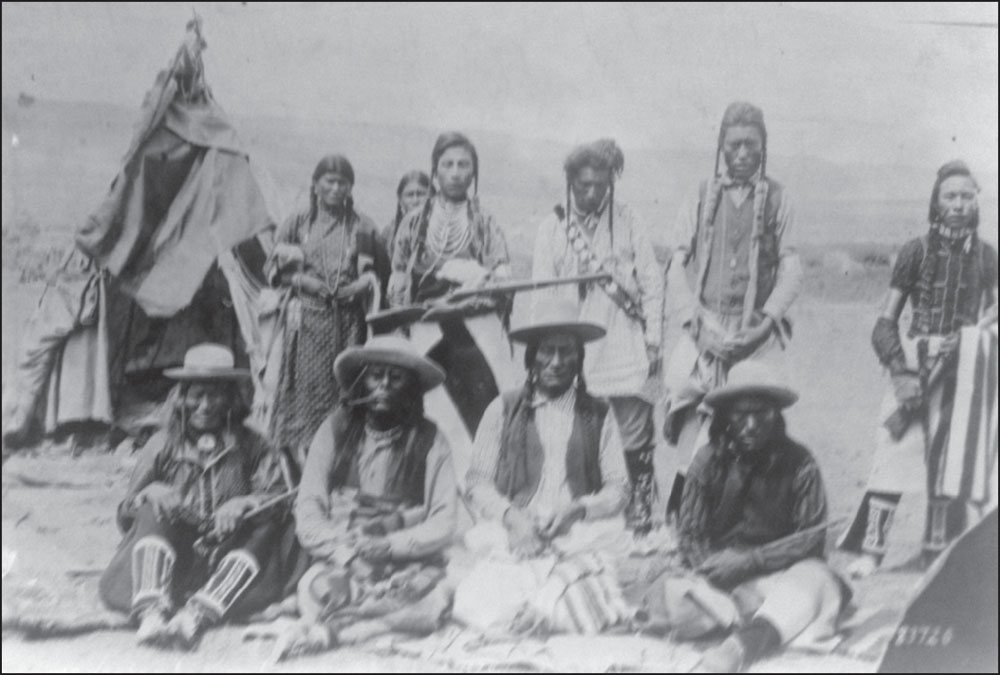
Gros Ventre leaders were held captive at Fort Curtis, Montana. The 2nd Cavalry Band, Companies C, D, and K, and the 11th Calvary Companies B, C, F, and H, were headquartered here in 1877. The Gros Ventres have lived around the western Great Lakes region for over 3,000 years. A farming community producing corn and other agricultural products, they lived in large cities with other Algonquian-speaking nations in present-day Minnesota and in Manitoba, Canada. (NARA 81720.)

“Cavalry vs. Indians,” seen here, helped create the romanticization and justification of the genocide of the indigenous population. Frederick Remington is known for his depictions of conquering the West; this may be one of his first sketches to be published as part of Lieutenant Bigelow’s journal in 1866. The image was reprinted in On the Bloody Trail of Geronimo, published by Western Lore Press in 1958, which continued the stereotypes of the Native Americans and the wars against them. (NARA 96838.)
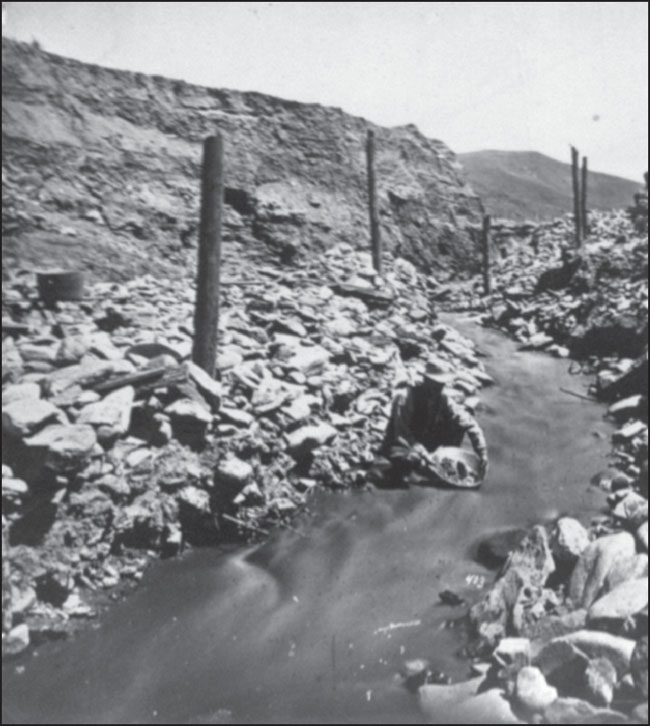
The discovery of gold in California in 1848 increased the policies of removing Native Americans. Federal cavalry troops organized more attacks, and gold miners also physically removed and slaughtered Native Americans. Since the gold miners knew they would not be punished for their actions, their attacks became more ruthless. Native Americans were unable to receive justice as the state of California denied them the right to testify in court. The state also encouraged white Americans and Californios to keep Indians as indentured servants. (NARA 57-HS-909.)
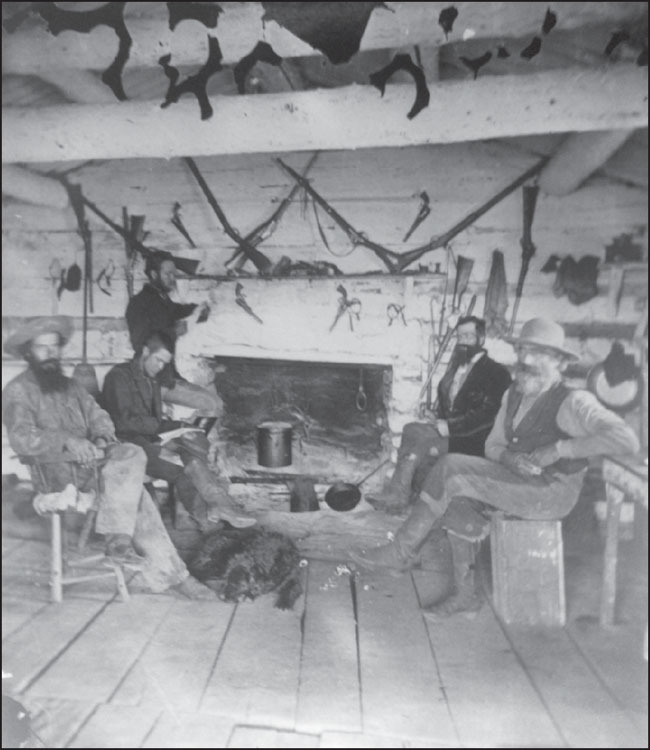
The Hayden Geological Survey, funded under the Department of the Interior, was one of many mapping and geological surveys that eventually became the US Geological Survey. Ferdinand V. Hayden, MD, started exploring the northern Great Plains region around 1853. The teams were sent out to photograph, take samples, and map the American West from 1869 through 1878. These areas later became national parks, which were protected by the US Cavalry. The National Park Service still emulates the organizational structure and attire of the US Cavalry. Here, William Jackson photographs the team in the kitchen. (NARA 57-HS-950.)
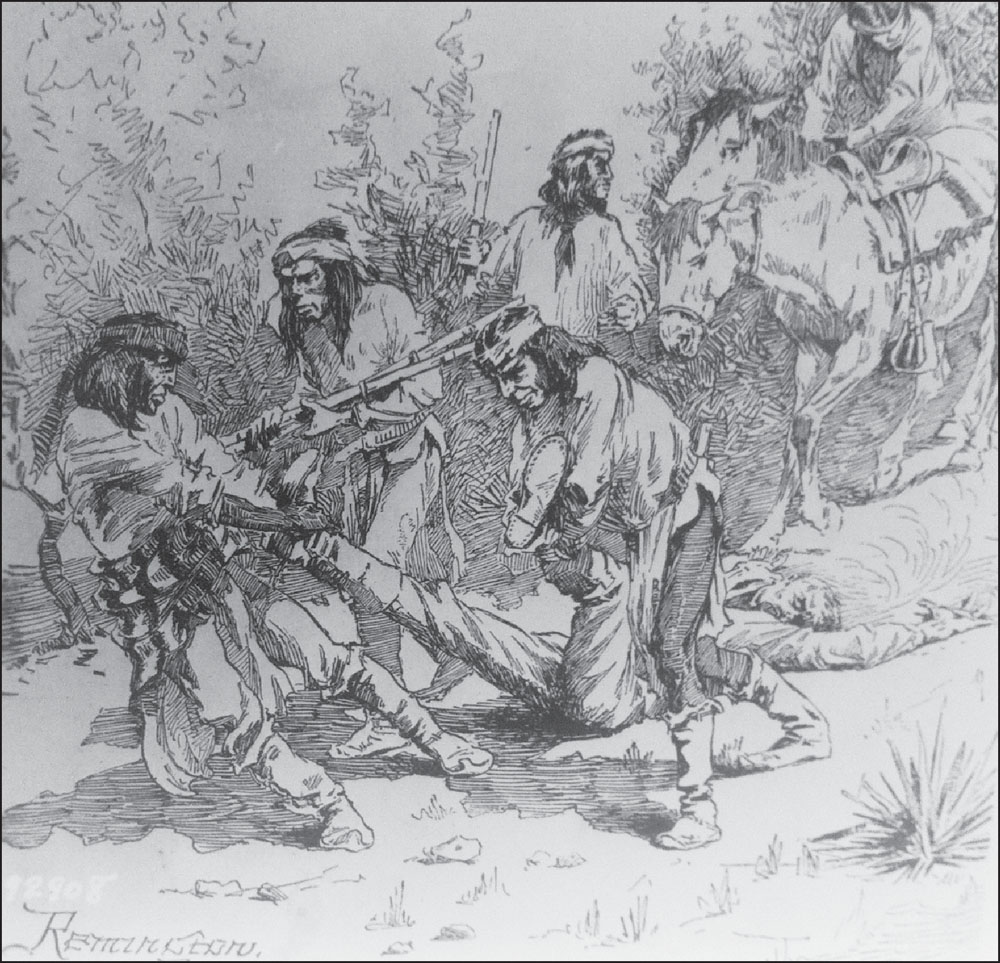
This Frederick Remington sketch, “He was dragged some distance off the road,” skews the balance of power between the US Cavalry and Native Americans. Images like these were used to increase funding for westward expansion from Congress and to justify the continued genocide of America’s indigenous peoples. Although scenes like this did occur, events in which the US Cavalry slaughtered entire populations were much more common. (NARA RG-111-SC.)
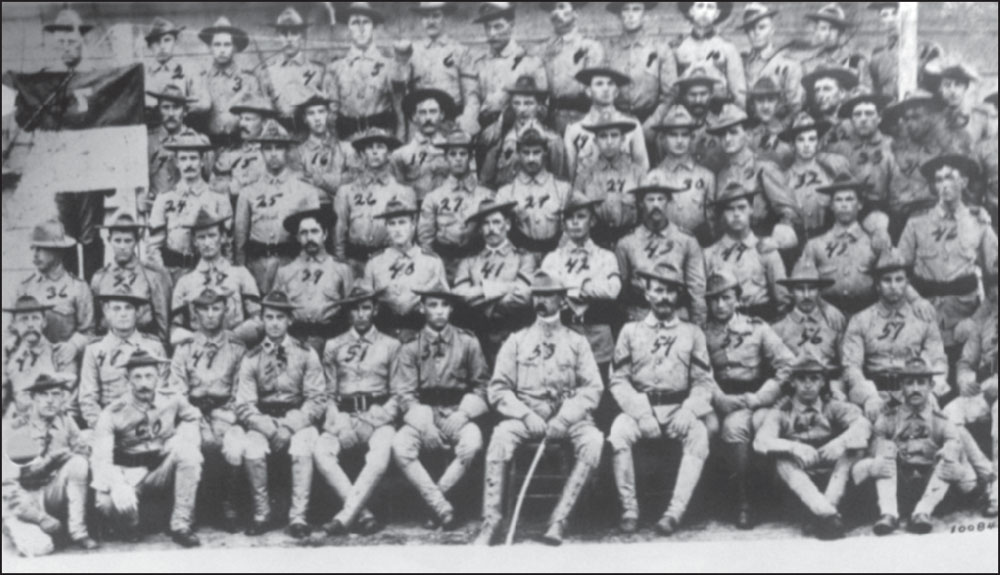
Pictured is the 2nd Squadron, Troop F, 7th Cavalry, in Camp Columbia, Havana, Cuba, in 1898. Congress declared war against Spain in April 1898 to liberate Cuba. Members of the 1st US Volunteer Cavalry, known as the Rough Riders and commanded by Theodore Roosevelt, were some of the first to arrive in Cuba. (NARA 100845.)
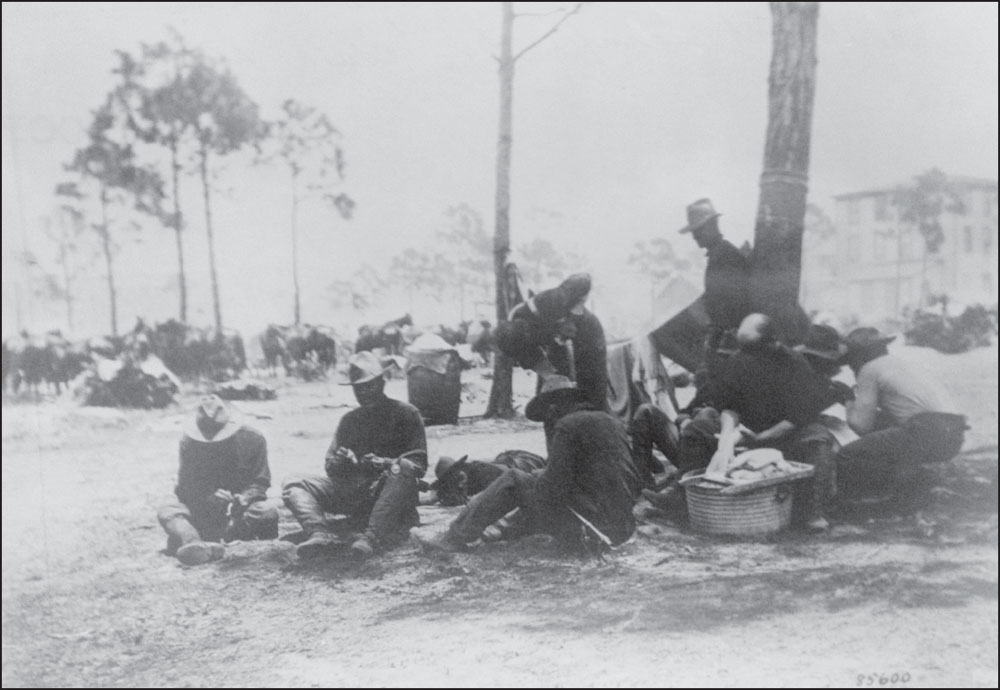
Troop K of the 9th Cavalry prepares for inspection in 1898. Many soldiers in the 9th Cavalry were awarded the Medal of Honor. Sgt. Emanuel Stance was the first African American regular to be awarded the Medal of Honor in June 1870. Sergeant Stance, 22 years old, was among the first troopers to enlist in the 9th Cavalry. (NARA 85600.)
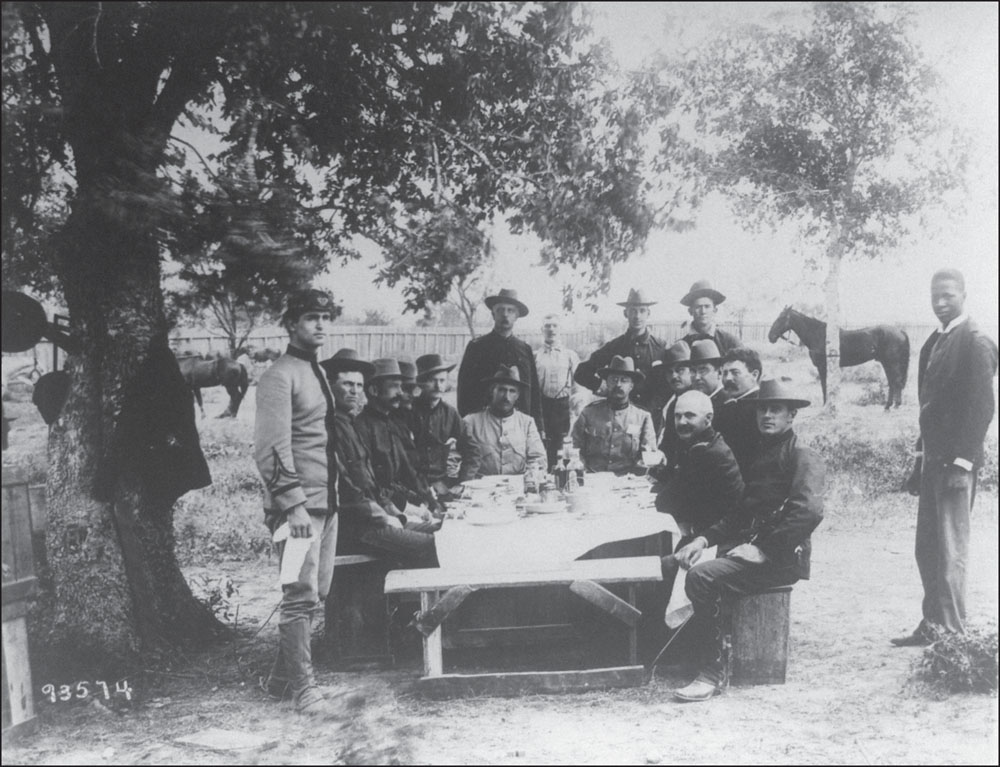
Pictured is the officers’ mess for the Rough Riders while in San Antonio, Texas, in 1898. Colonel Wood and Lieutenant Colonel Roosevelt are at the head of the table. Cadet Haskell, badly wounded in the San Juan Hill battle, is at the left. Lieutenant Pershing led the 10th Cavalry in Cuba in the assault on San Juan Hill. The troopers of the 10th took heavy casualties and served with distinction alongside Lt. Col. Theodore Roosevelt’s Rough Riders. The 9th and 10th Cavalry were the first established African American infantry regiments. (NARA 93574.)












































